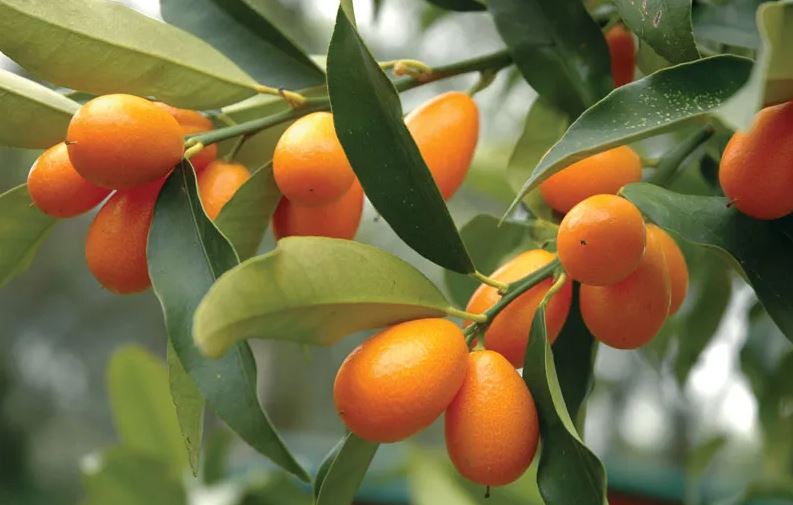
The word “kumquat” comes from the Cantonese “kam kwat,” which translates to “golden orange.” Kumquats are native to Southeast Asia and have been growing wild since ancient times. The fruits were first documented in China in the 12th century, grown for culinary, medicinal, and cultural uses, and were symbolically believed to bring good luck and prosperity when placed in households.
Kumquats were also extensively cultivated in Taiwan, Japan, the Philippines, and India in the early ages. In 1846, Kumquats were introduced into Europe by Robert Fortune, a Scottish botanist who was also a plant explorer for the London Horticultural Society. From Europe, Kumquats were brought to North America with immigrants and were planted in Florida as a potential fruit for commercial cultivation.
Kumquats resemble miniature oranges, typically oval or round, and about the size of a large olive. Their skin is bright orange when ripe. Unlike other citrus fruits, the skin of the kumquat is sweet and edible, while the flesh can be tart or sour. This creates a delightful contrast in flavors when eaten whole.
Kumquats are quite hardy for citrus plants. They can tolerate colder temperatures than many other citrus fruits but still thrive best in warm to subtropical climates. They’re popular in home gardens because they can be grown in pots, making them suitable for smaller spaces or as ornamental trees due to their decorative appeal when fruiting.
Kumquats have multiple fruiting seasons throughout the year in Asia and Southeast Asia. In the United States, the fruits are primarily available in the winter through early summer.
Kumquats can be eaten fresh, skin and all, which is how they’re often consumed to enjoy the contrast between the sweet rind and tart flesh. They’re used in marmalades, jams, and chutneys. Kumquats can also be candied, pickled, or used in salads and desserts. In mixology, the fruits are used as an edible garnish and can be infused into vodka for a citrus twist. The fruits can also be sliced and stirred into champagne cocktails, fruit punches, or sparkling juices.
In various cultures, kumquats are used in traditional dishes. For instance, in Chinese cuisine, they’re often preserved in sugar or honey and eaten during the Lunar New Year for good luck, symbolizing prosperity.
Kumquats pair well with nuts such as almonds, pecans, and walnuts, fruits, including calamondin, blood oranges, pineapple, kiwis, cranberries, and cherries, mint, honey, ginger, meats such as pork, duck, and poultry, seafood, and greens including watercress, spinach, endive, and frisee.
Kumquats are an excellent source of fiber to regulate the digestive tract and vitamin C to strengthen the immune system and reduce inflammation. The fruits also contain manganese, vitamin A to maintain healthy organ functioning, calcium to protect bones and teeth, and provide lower amounts of iron, zinc, potassium, vitamin E, and copper. Inside the sweet peel, essential oils such as limonene and flavonoids offer antioxidant and anti-inflammatory properties. Herbalists in Asia also use Kumquats as a remedy for symptoms of colds and flu. The fruits are traditionally smashed, mixed with ginger, salt, and honey, and steeped as a soothing tea.
Kumquats have been hybridized with other citrus to create new fruits like the limequat, lemonquat, and orangequat. There are several varieties, including the most common Nagami (oval) and Meiwa (round, sweeter, and often seedless). There’s also the Marumi, Hong Kong Wild, and others, each with slight variations in flavor and shape.
Today Kumquats are primarily grown in California and Florida of the United States, sometimes on a smaller scale in Texas and Louisiana, and are also cultivated in Asia, the Middle East, South Africa, Australia, Europe, and Central and South America. When in season, the fruits can be found fresh at farmer’s markets, specialty grocers, and select supermarkets.

Types of Kumquats
Nagami Kumquat (Fortunella margarita)
- Origin: Originally from China, it’s the most common variety in the United States.
- Characteristics: Oval in shape, with a tart, acidic flavor in the flesh, while the skin is sweet. It’s typically eaten whole.
Marumi Kumquat (Fortunella japonica)
- Origin: Japan, but also cultivated in China and now globally.
- Characteristics: Rounder than the Nagami, with a slightly sweeter taste overall. The skin is also edible and sweet, but the fruit can have a bit more of a spicy kick.
Meiwa Kumquat (Fortunella crassifolia)
- Origin: China, but widely grown in Japan where it’s known as Ninpo or Neiha Kinnan.
- Characteristics: This variety is sweeter and almost seedless or has very few seeds. It’s round and larger than other kumquats, with a flavor profile that’s less tart, making it popular for eating fresh.
Hong Kong Kumquat (Fortunella hindsii)
- Origin: Found in Hong Kong and surrounding regions.
- Characteristics: It’s the smallest of kumquats, often used more for ornamental purposes than for eating. The fruit is quite tart with very little sweet skin.
Jiangsu Kumquat (Fortunella obovata)
- Origin: From the Jiangsu province of China.
- Characteristics: It can be either round or bell-shaped. Known for its bright orange color when ripe, it has a sweet rind but can be quite tart inside.
Centennial Variegated Kumquat
- Origin: A relatively recent cultivar, possibly a mutation or hybrid.
- Characteristics: Known for its variegated leaves and fruit skin, which has stripes of green and yellow when immature, turning into a deep orange. The flavor is similar to the Nagami but can be less tart.
Malayan Kumquat (Fortunella polyandra)
- Origin: Malaysia, where it’s known as “limau pagar” or hedge lime.
- Characteristics: Typically used in cooking or for its zest. The fruit is small, round, and has a thinner skin compared to its cousins, with a taste that balances sweet and tart.
Australian Kumquats (varies but often related to Fortunella species)
- Origin: Adapted and cultivated in Australia, includes several hybrids.
- Characteristics: These might not be distinct species but rather cultivars adapted to local conditions, often focusing on larger fruit size or different flavor profiles.
Calamondin (Citrofortunella microcarpa)
- Origin: Believed to be a hybrid of kumquat and mandarin orange, originally from the Philippines.
- Characteristics: While not a true kumquat, it’s often grouped with them. It looks like a tiny orange, with a very tart juice but a sweet peel. Often used for its juice in drinks or as a flavoring.
Limequat (Citrus × Fortunella hybrid)
- Origin: A hybrid created by crossing key lime with kumquat, developed by Walter Swingle in 1909.
- Characteristics: Limequats have a lime-like flavor with a kumquat’s edible skin. They are usually more lime-green when ripe, smaller than a lime, and can be used similarly in culinary applications.